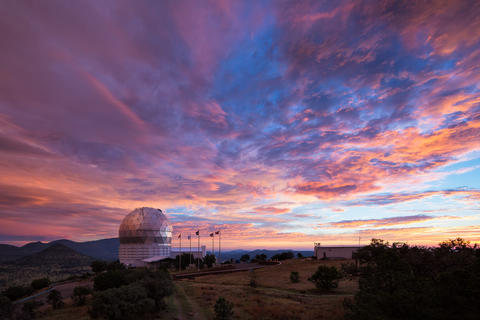Why NIST Is Going to Space

Hobby-Eberly Telescope
NIST is extending its measurement expertise into space, developing instruments to provide new and more accurate information about the universe, including the Earth and its climate. Study targets include ancient radiation patterns and light from astronomical objects such as the stars. Often such measurements must be done, or can gather more data, in space. This allows researchers to “see” beyond Earth’s interfering atmosphere and often cover more of the sky with a single instrument.
Much of the latest NIST technology helps scientists around the world understand the features and evolution of the universe. For example, NIST sensors and electronics help astrophysicists study the cosmic microwave background (CMB), the afterglow left over from the first moments of the hot, dense early universe. By looking out in space, scientists look back in time. NIST sensors and electronics are mounted on telescope cameras to search for tiny energy fluctuations and other telltale patterns that are clues to the formation of galaxies and other structures after the birth of the universe 13.8 billion years ago.
According to the leading theory, the baby universe expanded explosively — the Big Bang — in a way that shaped the distribution of matter and radiation in the cosmos. During a theorized period of inflation in the very early universe, quantum fluctuations were magnified into imprints that can be imaged today. Over epochs of time, some regions became denser due to gravity, forming galaxies. Scientists look for traces of these processes with instruments that can detect faint, diffuse light characteristic of the CMB. For instance, these instruments may detect ripples in space-time, or gravitational waves, that would provide strong evidence of inflation.
Telescope designers choose NIST’s superconducting sensors because they offer record sensitivity to faint light, can be customized to detect many colors, and can be packaged to minimize systematic errors. NIST amplifiers help boost signal strength, and NIST’s unique electronics make large sensor arrays possible by combining all data simultaneously in a minimum number of wires.
NIST’s transition-edge sensors (TESs) measure light by detecting its heat, based on an increase in the electrical resistance of a superconducting film. When used to measure X-rays (a form of light), which are very strong, these sensors can measure the energy of the smallest light particle, or photon, with an error of less than one part in a thousand. For telescopes looking at the faint CMB, these sensors can measure both the light intensity of microwave light and the light waves’ geometric orientation, or polarization, at the fundamental limits of sensitivity. Through use of different materials and designs, TESs can be tailored to different applications, including the detection of multiple colors of light, a way of distinguishing real CMB signals from astrophysical interference. When assembled into arrays of hundreds or even thousands, these sensors combine precise measurements and collection efficiency not possible with other technologies.
NIST also makes another type of superconducting sensor, microwave kinetic inductance detectors (MKIDs), whose frequency changes as photons arrive. These detectors, generally used for frequencies higher than those found in the CMB, are easier to combine into larger arrays than TESs are and are installed on a few telescopes.
Many sensors are combined to make telescope cameras that image large areas of the sky. As photons arrive at a telescope, they are channeled by tapered cylinders called feedhorns onto an antenna on the surface of chips containing a number of sensors. Signals are amplified by superconducting quantum interference devices (SQUIDs). When a photon changes the TES current, this in turn changes the magnetic field measured by a SQUID.
Counting signals individually from each sensor would create too much heat, so operation of large sensor arrays requires simultaneous assembly of the data, known as multiplexed readout. NIST researchers invented a method for wiring hundreds of SQUID signal amplifiers together to make large arrays of superconducting detectors practical. The NIST chips, which along with the sensors are chilled to cryogenic temperatures, also assemble the signals into a sequential time stream that can be read by conventional room-temperature electronics.
NIST also provides other types of ultraprecise light-measuring technologies for telescopes and satellites. These custom systems include frequency combs to help search for Earth-like planets and radiometers to help measure the Sun’s energy. NIST researchers are also measuring light from stars and reflections from the Moon to ensure the accuracy of astrophysics studies and satellites monitoring the Earth’s weather and climate.
For more details, see the individual pages for each installation.
Interested in Participating in This Research?
Check out these opportunities:
More details about these research projects:
Boulder Microfabrication Facility

